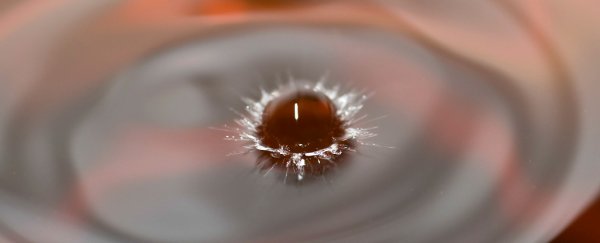Researchers in the US say they've created a fluid with negative mass in the lab… which is exactly as mind-bending as it sounds.
What it means is that, unlike pretty much every other known physical object, when you push this fluid, it accelerates backwards instead of moving forwards. Such an oddity could tell scientists about some of the strange behaviour that happens within black holes and neutron stars.
But let's take a step back for a second here, because how can something have negative mass?
Hypothetically speaking, matter should be able to have negative mass in the same way that an electric charge can be either negative or positive.
On paper that works, but it's still debated in the science world whether negative mass objects can really exist without breaking the laws of physics - something that's not helped by the fact that the very concept is hard for us mere humans to wrap our heads around.
Isaac Newton's Second Law of Motion is often written as the formula f=ma, or force equals an object's mass times its acceleration.
If we rewrite it as acceleration is equal to a force divided by the object's mass, and make the mass negative, it would have negative acceleration - just imagine sliding a glass across a table and having it push back against your hand.
However, just because it seems foreign to us, doesn't mean it's impossible, and previous theoretical research has shown some early evidence that negative mass could exist within our Universe without breaking the theory of general relativity.
More than that, many physicists think that negative mass could be linked to some of the weird things we've detected in the Universe, such as dark energy, black holes, and neutron stars.
As a result, researchers have been actively trying to recreate negative mass in the lab, with some early success.
But now researchers from Washington State University say they've successfully managed to get a fluid of superchilled atoms to act as though it has negative mass - and suggest it could finally be used to study some of the stranger phenomena happening in the deep Universe.
"What's a first here is the exquisite control we have over the nature of this negative mass, without any other complications," said one of the researchers, Michael Forbes.
To create this strange fluid, the team used lasers to cool rubidium atoms to a fraction above absolute zero, creating what's known as a Bose-Einstein condensate.
In this state, particles move incredibly slowly and follow the strange principles of quantum mechanics, rather than classical physics - which means they start to behave like waves, with a location that can't be precisely pinpointed.
The particles also sync up and move in unison, forming what's known as a superfluid - a substance that flows without losing energy to friction.
The team used lasers to keep this superfluid at the icy temperatures, but also to trap it in a tiny bowl-like field measuring less than 100 microns across.
While the superfluid remained contained in that space it had regular mass and, as far as Bose-Einstein condensates go, was pretty normal. But then the team forced the superfluid to escape.
Using a second set of lasers, they kicked the atoms back and forth to change their spin, breaking the 'bowl' and allowing the rubidium to come rushing out so fast that it behaved as if it had negative mass.
"Once you push, it accelerates backwards," said Forbes. "It looks like the rubidium hits an invisible wall."
So far, the researchers state that the negative mass fluid confirms what other teams have seen in their research, but it's very early days.
It's yet to be seen whether this escaping superfluid will be reliable and accurate enough to test out some of the very strange suggestions about negative mass in the lab, and before we get too excited, other teams need to replicate the results independently.
But the research has now been published in the peer-reviewed journal Physical Review Letters for anyone to try their hand at. So hopefully it won't be long before we see the experiment recreated.
One thing's for sure, physics just keeps getting weirder, and we're pretty excited to see what happens next.
